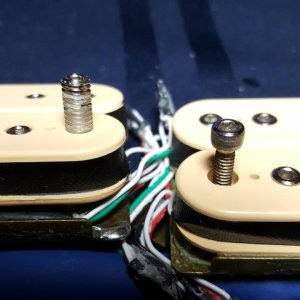Re: Two rows of identical allen screws kill clarity..
I've been doing tests lately between regular slugs and hex (grub) screws. I realise two identical coils cancel tone best, but also cancel alot of majic high frequencies. Pickups like the Super Distortion have very little harmonics or high-end definition. Both coils must have a difference in number of turns (or wire gauge [dual-resonance]) or different screws/slugs. Otherwise the pickup will sound like a brick (imo).
Another thing also is the notion that hex screws sound just like slugs except they're adjustable... sorry they don't. They sound less full, more hollow and bright. They probably diffuse the magnetic field very differently at the top.
More testing to come between classic fillister screws and socket cap hex screws
The sonic difference between hex screws and slugs/filister is a can of worms that I'll prudently avoid to dig... Granted, this question involves relatively clear principles if we consider them isolately (less mass = less inductance, less lenght protuding below the baseplate = less Foucault currents) but there's other variables at work and on the basis of our own experiments, I don't find easy to clarify the intricated causes of tonal changes.
EDIT - For example, we've noticed and measured with lab gear a difference between plated and unplated screw poles meant to be made of a same alloy. But was it effectively the same alloy? We'd have to do a destructive lab analysis to know it. "The devil is in the details".

Now, I see what you mean about strictly identical BOBBINS (= same coils on same frames and same poles) as impacting the high range: IME (and all other parms being equal), such a symetry tends to diminish the secondary resonant peaks produced by some other designs and, therefore, flattens the upper harmonics. That's probably why DiMarzio patented the Dual-Resonance thing, after all.

If I can share a few things as footnotes, here we go:
1-even with hex poles, unscrewing the poles of a few mm on one row (in one coil) only is still a way to recreate an assymetry between bobbins : it changes the relationship of the humbucker with the strings and the inductance of the related coil (it's funny to unscrew the poles of a P.A.F. style humbucker and to see its inductance rising progressively, while this inductance will drop as soon as the poles are screwed down);
2-The stray capacitance of 4 wires cables contributes to create "Dual-Resonance" by increasing the capacitive mismatching between coils... And it's possible to take advantage of this feature. Gibson did it radically with the "fat tap" thingy but it's not forbidden to connect a LOW VALUE capacitor to ground at the junction between coils and to obtain a "Dual-Resonance" affecting the upper harmonics. With a generic humbucker, a 270pF cap, for instance, would create a dip in the response around 8khz and generate a secondary peak around 10khz, giving more sparkle (unless we keep the longest possible quantity of 4 wires cable in the guitar since such a cable is itself a tubular assortement of low value caps. LOL).
Non limitative list of possible solutions against the "brick syndrome". FWIW.

)

